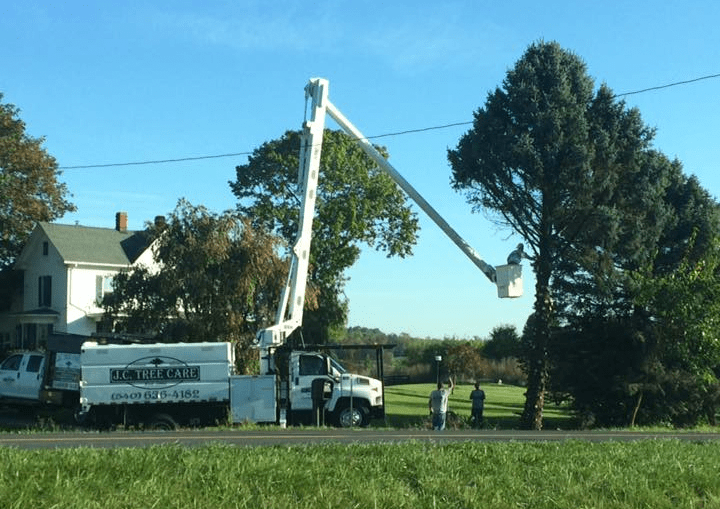Benefits of Tree Trimming and How Often It Should Be Done
While a house surrounded by a landscape of trees can be a beautiful visual, it can also pose a threat for falling branches or rotting trees if not properly maintained. How often and when to prune your trees depends on factors such as the type of tree and time of year. Whether you decide to prune your tree’s branches yourself or contact your local tree care professional to do it for you, this guide provides you with all you need to know about tree trimming in Virginia.
Why Tree Trimming and Pruning is Necessary
The Department of Agriculture insists there are three main reasons to keep your trees’ branches trimmed and pruned regularly: safety, health, and aesthetics.
- Safety – Weak branches pose a safety concern for those who walk around the property or underneath your tree. If a larger branch were to fall on someone’s head, it could seriously injure them. Trimming weak branches keeps your home safer and improves the strength of your tree. You may also want to thin out your tree so thick branches pose less of a safety risk.
- Tree Health – Trees are prone to disease just like humans. If you notice signs of rot or disease, you should remove these immediately or your entire tree could die. The process of pruning (removing dead or diseased branches) improves overall tree health, resulting in stronger trees that can produce more flowers or fruit.
- Visual Aesthetics – Pruning dead or diseased branches not only improves your tree’s overall health, but also its appearance. In the absence of ugly rotting branches, your tree is likely to be greener, branches growing properly, overall healthier looking. This can increase the value of your property.
How Often Should You Trim & Prune?
There are many different species of trees, but there are three distinct types that have entirely different trimming schedules.
- Evergreen Trees: This particular type of tree needs the least pruning because it self regulates itself by shedding damaged or dead branches. Trimming may only be necessary to prevent safety hazards like a loose branch that could fall on someone’s head. Other than this, it’s advisable to mostly leave evergreen trees alone.
- Oak Trees: The advisable amount of trimming for oak trees depends on their age. When they’re young, they need to be trimmed more often, about every 2 to 3 years. Once they’ve matured with age, they will only need to be trimmed every 3 to 5 years.
- Fruit Trees: Fruit trees need the most attention, requiring annual pruning. While you can trim them all year round, be careful not to overdo it. A small trim when necessary can help encourage new fruit growth.
What Time of Year Should You Prune?
This, again, depends on the type of tree you’re dealing with. Generally speaking, you almost always need to prune your trees during the dormant season (when trees shed their leaves to conserve energy and new growth hasn’t started yet). This season usually occurs directly after Winter.
Oak trees should be pruned through October to March. However, pruning during April through June should be avoided at all costs. This is because oak trees can succumb to a disease called oak wilt which is very deadly and is most prominent during the Summer months.
Fruit trees can be trimmed as needed all year round, including the dormant months. The dormant season is the best time to trim your fruit trees. This is typically around December to February.
How to Trim & Prune Trees
When it comes to trimming your trees, you may want to contact a professional tree care specialist to do this for you, especially if branches come into contact with power lines. Smaller, thinner branches about 2 inches in diameter can be handled without professional help.
However, anything bigger than that may not be a good idea to take on by yourself. Branches larger than 4 inches should not even be attempted without professional help, nor should you trim any branches that come close to power lines.
If you do decide you can handle trimming your trees yourself, you’ll need protective safety goggles so nothing damages your eyes. In addition to that, you’ll need pruning shears and a pruning saw.
Identify the branch collar on the tree branch you want to remove and cut downwards to prevent water from settling, which can result in disease and rotting. Branch collars are thicker than the rest of the branch and are located near the base.
Conclusion
The importance of maintaining properly trimmed and pruned trees along your property cannot be overstated. This is vital to ensure your and others’ safety, optimal aesthetics of your home, and to keep your trees healthy.
Use this guide to aid you in figuring out when and how often to trim your trees. Always take proper safety precautions if you will be pruning or trimming yourself and don’t attempt to trim trees that are extremely thick in diameter or close to power lines.
If you don’t feel comfortable or if it’s not safe for you to trim and prune your trees yourself, contact us at JC Tree Care today and we’ll send out a team of professional tree care specialists to get it done for you. Call us today to get a free estimate. We offer emergency tree care services such as tree removal, pruning, stump grinding, and more.
